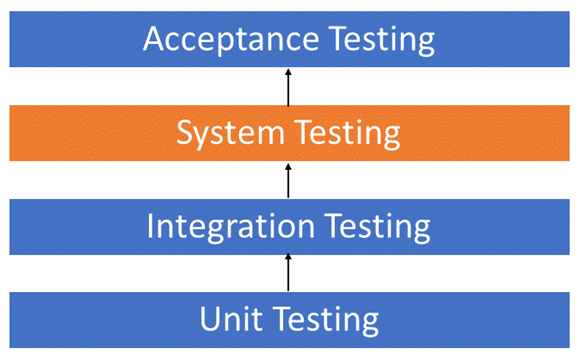1. What is System testing?
System testing is a level of software testing process when modules and modules are integrated. The purpose of system testing is to evaluate whether the software system has been fully and completely integrated, check how the components interact with each other and the whole system, thereby assessing the software. comply with the requirements set forth.
Key differences between Integration Test and System Test:
- System Test focuses on behaviors and errors throughout the system
- Integration Test focuses on the communication between entities or objects as they work together.
Usually we have to do Unit Test and Integration Test to make sure all Units and their interaction work correctly before running System Test.
The system test is performed by the black box testing method, ie only the external working features of the software are evaluated during this test. It does not require any internal knowledge about coding, programming, design, etc. and is entirely based on the user’s point of view.

2. Reason for implementing System Testing:
Some reasons to perform this system test are:
- Ensure products meet quality standards.
- Verify the software system meets the functional, technical and business requirements of the customer.
- Performing end-to-end testing of software products helps prevent system errors and failures during real-world performance.
- This is done in an environment similar to the production environment, allowing developers as well as stakeholders to get an idea of how users respond to the product.
- Play an important role in providing a quality product to end users.
- Ensure that the input is provided with the expected output / result.
3. Types of testing used in system testing
Like software testing, system testing is also a combination of versatile testing techniques, which can confirm the overall performance and functionality of a product. Each of these testing techniques is focused on different aspects of the product and serves the different requirements of the customer / user. What types of testing are used:
- Installation test: It is used to check the desired function of the software after a successful installation along with all the necessary requirements.
- Functional Testing: Assessing the software to meet the requirements given before, it is possible to make a list of additional functions to improve the product.
- Usability Testing: mainly focuses on user ease of use of the software, flexibility in handling controls and ability to meet software goals.
- Load Testing: to know the actual load capacity of the application
- Regression Testing: Ensure there are no problems in the development process as well as the original functions are still working properly without errors when there is a change in the code.
- Security Check: To evaluate the security features of the software to ensure, protect, authenticate, secure and the integrity of information and data.
- Recovery Testing: It is done by trying to make software crash or fail, to evaluate the ability of the product to recover quickly, reliably and recoverable. Success from the incidents may occur
- Migration Testing: performed to ensure that software can be migrated from the old system infrastructure to the existing system infrastructure without any problems.
- Interoperability testing: It ensures software compatibility and interaction with other software or systems and their components.
Depending on the requirements of each system, Tester will have different criteria to choose the appropriate test type, for example based on criteria.
- Who the testers work for – This is a key factor in determining the types of system tests that testers will use. The methods used by large companies differ from those used by small and medium-sized companies.
- Time spent on testing – Time is often what limits us to using only the most relevant types of software projects.
- Resources for testing – Of course some testers will not have all the resources needed to conduct this type of testing. For example, if you are a tester working for a large software development company, you may have expensive automated testing software not available to others.
- Tester’s knowledge – Each type of test will require certain background knowledge, so testers must meet that knowledge before they can make full use of the value of the test type.
- Budget Check – Money becomes a factor not only for smaller companies and individual software developers but also for large companies.
Conclude
System testing is an integral part of the software testing life cycle, performed when the software development process is complete and the product has gone through unit testing and integration. This test is not limited to one aspect or component of the product, but is used to test the entire software system, which makes it an important part of any test cycle. It is therefore implemented by tester to provide the best user experience
